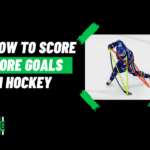For those who have never watched the game of hockey, a referee signaling a penalty can be confusing. While there are a number of penalties in hockey, there are a few that are called more frequently than others.
The most common penalties called throughout a hockey game are tripping, interference, roughing, too many men on the ice, boarding, unsportsmanlike conduct, cross-checking, high sticking, and hooking. Of course, these penalties are the most common as they’re the ones that happen most frequently on the ice.
Table of Contents:
- Result of taking a penalty
- Hockey Penalty Terminology
- Is it possible to score on yourself during a delayed penalty?
- Difference between minor and major penalties
- Alphabetical List of Hockey Penalties and Their Definition
- Penalty Rules in Ice Hockey
What happens as a result of a penalty in hockey?
When a team takes a penalty, they are in what’s referred to as a “penalty kill” situation. On the other hand, the team that has the advantage goes on what’s called the “power play”. Penalties in hockey play a large significance in the outcome of the game. This is because when a penalty is called, the team who took the penalty is forced to play with one less (or more) player.
There are 5 different classes of penalties in the game of hockey, as defined by USA Hockey.
- Minor/Bench Minor Penalties
- Major Penalties
- Misconduct Penalties
- Match Penalties
- Penalty Shot
While a penalty results in the offending team being forced to play with one less person on the ice, it’s important to note that a team can never have less than 3 players on the ice. The greatest advantage a team can have in terms of players on the ice is a 6 on 3 advantage, with two players on the opposing team serving penalties and the attacking team having pulled their goalie.
Hockey Penalty Terminology
Power Play
When a team commits a penalty, the opposing team goes on what is referred to as a “Power Play”. This is because they have an advantage in the number of players on the ice as compared to the team who committed a penalty. Most common types of Power Play scenarios are a 5 on 4 (single player advantage), a 5 on 3 (two player advantage) or a 6-3 (3 player advantage, Power Play team plays without their goalie).
Penalty Kill
When a team commits a penalty, they are in a scenario referred to as the “Penalty Kill”. The Penalty Kill is the opposite of a Power Play, where instead of a player advantage, the team plays with one or two less players. The lowest number of players on the ice for a penalty kill will never be lower than 3. There are no limits to the number of players serving penalties at one time, as long as the team on the ice can provide 3 players to “Kill” the penalties. Read our post on “hockey terminology” for more information!
Delayed Penalty
If a penalty is committed and the team who committed the penalty is not in control of the puck, the scenario is known as a “Delayed Penalty”. In a Delayed Penalty situation, the team who will soon be on the Power Play gets to take their goalie out to go on an early one player advantage until the team who has committed the penalty gains control of the puck.
Can the team going on the Power Play get scored on in a Delayed Penalty scenario?
In a Delayed Penalty, the team who committed the penalty cannot score by shooting the puck themselves, even though there is no goalie. This is because the second they gain control of the puck, the referee whistles to signal the end of play. However, if the team going on the Power Play shoots the puck into their own net, a goal is counted.
In the video below, Washington Capitals player Carl Hagelin passes the puck into his own net on a Delayed Penalty scenario, technically “scoring” for the opposing team.
Penalty Shot
A penalty shot is called when the referee determines that the team who committed a penalty directly prevented a sure goal as a result of their infraction. Penalty Shot scenarios are rare and most commonly the result of a hooking or tripping penalty.
Minor Penalty
A minor penalty is a 2-minute penalty, the most common type of penalty. A minor penalty can turn into a “Double Minor” penalty which doubles the time served on the penalty to 4 minutes total.
Can A Goalie Serve a Minor Penalty?
In the game of ice hockey, penalties can be called on the goalie. These are most often tripping, slashing, or interference. In the case of a goalie committing a minor penalty, the goalie will continue to play and one of his or her teammates will serve the penalty.
A goalie can receive a trip to the penalty box, in the case of a Major Penalty. In the case of a goalie called for a Major Penalty, they will often leave the ice, especially at the National Hockey League level, where they are most likely to be called. A goalie committing a major penalty is rare in the game of hockey.
Major Penalty
Major Penalties, most commonly called for fighting at the professional level, carry a 5 minute penalty time served. At the amateur level, a major penalty is most often called in boarding, checking from behind, or head contact scenarios. When a Major Penalty is called, the team on the Power Play can score at will, with the offending player forced to serve the entirety of the penalty in the penalty box.
When a Major Penalty is called, even if players from both teams are called for a Major penalty, both teams play at a disadvantage. This means that when the penalty time expires from a major penalty, the player or players serving this penalty are eligible to immediately return to the field of play.
Explaining the Difference in Minor and Major Penalties
In the game of hockey, there are several classifications of penalties. The majority of hockey penalties issued by referees are what is referred to as “Minor Penalties”. Minor Penalties are a simple 2 minute trip to the penalty box. A hockey referee can issue a “Double Minor”, a “Major Penalty”, or a “Misconduct Penalty” in addition to any penalty called.
Misconduct Penalty
When a misconduct penalty is called, there are two scenarios. The first scenario is called a “Game Misconduct Penalty”. When a game misconduct penalty is called, the player is removed from the game as a result of their penalty. The other type of misconduct penalty is a 10-minute penalty in which the offending player is required to sit in the box for 10 minutes of play and is only eligible to leave the penalty box when the 10 minutes have passed and a whistle is blown. Players cannot leave the penalty box and onto an active playing surface after a Misconduct penalty is called. Misconduct penalties are often called a “Game Misconduct penalty”.
A Misconduct penalty often results in further disciplinary action, depending on which level of play the player is currently at and what their league dictactes should be the case in the event of a Misconduct. Oftentimes, the penalized player will be forced to miss additional playing time. Misconduct penalties are most often called in cases where a player fights or is called for deliberately injuring an opposing player. In some leagues, Misconducts result in an automatic suspension of the player.
Is it a Penalty Kill when a Misconduct Penalty is called?
When a 10 minute Misconduct Penalty is called, it will often be called in addition to a Minor Penalty, such as Unsportsmanlike conduct. In this case, the Power Play is only 2 minutes long, or the length of the penalty (or penalties) called in addition to the Misconduct penalty.
Alphabetical List of Hockey Penalties and Their Definition
Boarding
Charging
Contact to the Head / Head Contact
Checking From Behind
Cross Checking
Elbowing
High Sticking
Holding
Hooking
Interference
Misconduct Penalty
Roughing
Slashing
Spearing
Tripping
Too Many Men On The Ice
Penalty Rules in Ice Hockey
Face-offs
The next face-off after a Penalty is called, takes place inside the zone of penalized team who committed the penalty action. If both teams took a penalty and the penalties are “coincidental”, the face-off occurs at Center Ice.
What happens when penalties on the same team expire at the same time?
When two penalties on the same team expire at the same time, the Captain of the team who committed the penalties shall determine which player returns to the ice first.
Coincidental penalties
When coincidental penalties are called, the players will serve their minimum of two minutes in the penalty box, but do not return to the ice when the penalty expires. The players shall only return to the ice when the penalty has expired and play has been whistled dead by a referee. This is because in the case of coincidental penalties, both teams may have 5 players on the ice and the returning players would create a “Too Many Men on the Ice” penalty.
Major Penalty Rules
Match Penalty Rules
When a Match penalty is enforced, the player or team official to who the penalty is called upon is immediately removed from the game. Additionally, a 5-minute major penalty is called on the team receiving the Match Penalty. Match penalties are recorded as an additional 10-minute penalty, though this is not served by the team, it’s simply for record keeping. Match penalties often result in additional suspension, but this is determined by the league in which the team is a part of.
In USA Hockey, when a Match Penalty is called, the player or team official will have to go through a hearing process to return to team activities or play. When a Match penalty has been committed, the player or team official is immediately removed from the game and not allowed to be near the bench or locker room area, nor are they allowed to participate in team activities until a hearing has been completed and return to play / practice approved.
Conclusion
As you now know, there are a lot of different penalties in the game of hockey. This is a complete guide to everything that you need to know about penalties. Hopefully you found it helpful! If you are interested in other hockey related content – check out or blog on how long a hockey game lasts.



